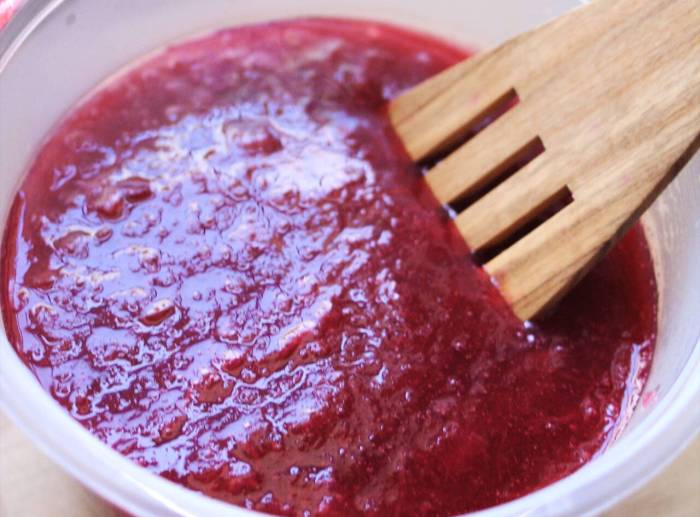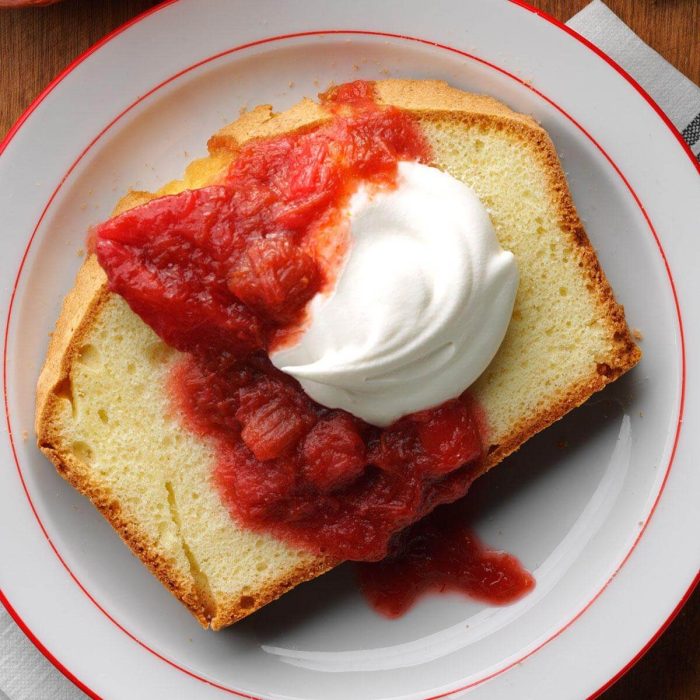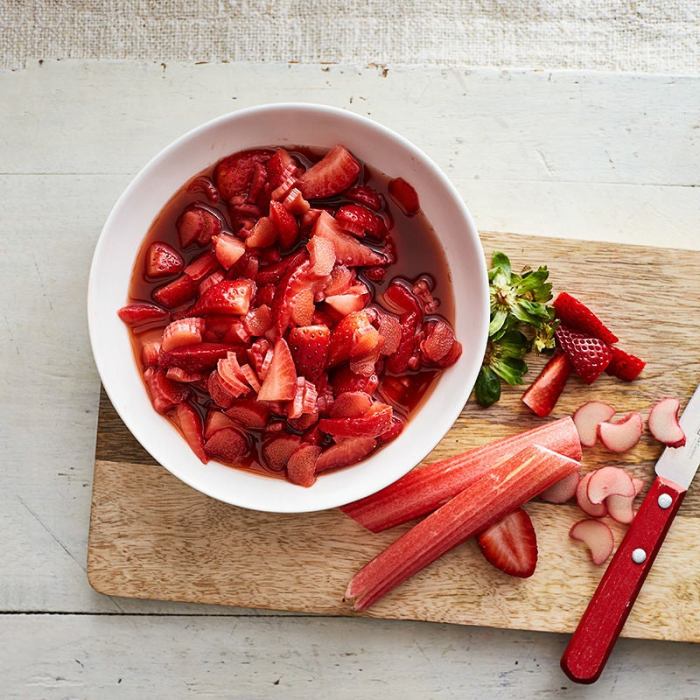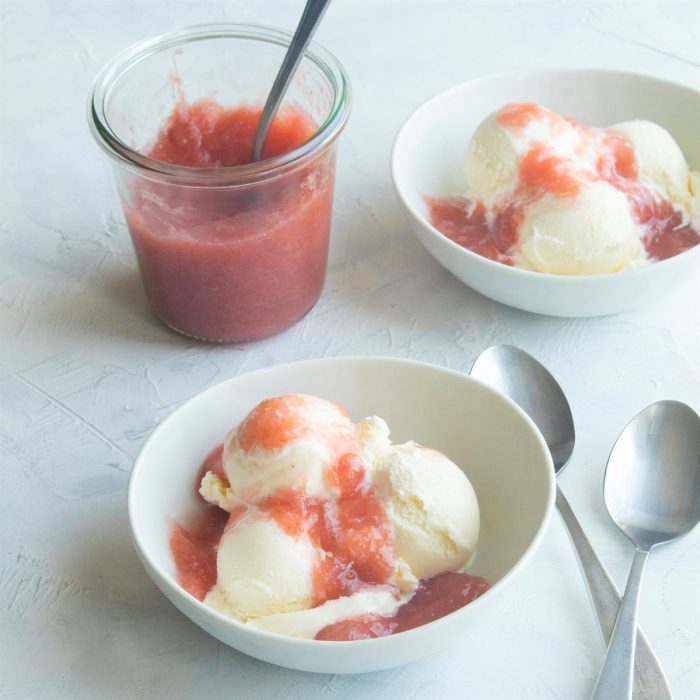Rhubarb sauce recipe, a culinary treasure, offers a delightful blend of sweet and tart flavors. This versatile sauce, with its origins deeply rooted in history, has found its way into countless cuisines around the world. From its humble beginnings as a simple dessert topping to its current status as a key ingredient in both savory and sweet dishes, rhubarb sauce continues to captivate taste buds with its unique combination of flavors and textures.
The beauty of rhubarb sauce lies in its adaptability. Whether you prefer a classic recipe or are looking to explore variations with different sweeteners, spices, and flavorings, there’s a rhubarb sauce recipe to suit every taste. The possibilities are endless, from pairing it with fresh berries and whipped cream for a classic dessert to using it as a glaze for roasted chicken or a sauce for pork chops.
Rhubarb sauce’s versatility makes it a kitchen staple for both novice and seasoned cooks alike.
Introduction to Rhubarb Sauce

Rhubarb sauce, a sweet and tangy condiment, has been enjoyed for centuries, with its origins tracing back to ancient civilizations. This versatile sauce, made from the stalks of the rhubarb plant, has found its way into countless culinary traditions worldwide.
From its humble beginnings as a traditional remedy to its modern-day status as a beloved ingredient, rhubarb sauce has captivated taste buds and inspired culinary creativity.The versatility of rhubarb sauce extends beyond its sweet and tangy profile. Its unique flavor profile complements a wide range of dishes, from savory meats and poultry to sweet desserts and baked goods.
Its tartness balances the richness of desserts, while its vibrant color adds visual appeal.
Nutritional Benefits of Rhubarb
Rhubarb is a nutritional powerhouse, packed with vitamins, minerals, and antioxidants. Its high fiber content aids digestion, while its low-calorie count makes it a healthy addition to any diet. Rhubarb is also a good source of vitamin K, which plays a vital role in blood clotting and bone health.
Ingredients and Variations
A basic rhubarb sauce recipe requires just a few essential ingredients, but there are many ways to customize it to your liking. You can experiment with different sweeteners, spices, and flavorings to create a sauce that perfectly suits your taste buds.
Essential Ingredients
The basic ingredients for a rhubarb sauce are:
- Rhubarb: The star of the show, rhubarb adds a tart and tangy flavor to the sauce. You can use fresh or frozen rhubarb, but fresh rhubarb will have a more intense flavor.
- Sugar: Sugar balances out the tartness of the rhubarb and adds sweetness to the sauce. You can use granulated sugar, brown sugar, or even honey or maple syrup as a substitute.
- Water: Water helps to create a smooth and consistent sauce. You may need to adjust the amount of water depending on the type of rhubarb you are using and the desired consistency of the sauce.
Variations
There are many ways to add your own personal touch to rhubarb sauce. Here are a few common variations:
- Regional Preferences:In some regions, rhubarb sauce is traditionally flavored with spices like cinnamon, ginger, or nutmeg. For example, in the American South, it is common to add a pinch of ground cinnamon to the sauce.
- Dietary Restrictions:For those with dietary restrictions, there are many ways to make rhubarb sauce more accessible. For example, you can use a sugar substitute like stevia or erythritol to make a low-sugar version. You can also use cornstarch or arrowroot powder to thicken the sauce without using gluten.
- Flavorings:You can add a variety of flavorings to your rhubarb sauce to create unique and delicious variations. For example, you can add a splash of vanilla extract, a squeeze of lemon juice, or a handful of fresh berries.
Alternative Sweeteners
As mentioned earlier, there are many alternatives to traditional sugar that can be used to sweeten rhubarb sauce. Some popular options include:
- Honey:Honey adds a unique floral flavor to the sauce. It is also a good source of antioxidants.
- Maple Syrup:Maple syrup adds a rich and complex flavor to the sauce. It is also a good source of vitamins and minerals.
- Agave Nectar:Agave nectar is a popular sweetener that is lower in fructose than sugar. It has a mild, sweet flavor.
- Stevia:Stevia is a natural, zero-calorie sweetener that is derived from the stevia plant. It is much sweeter than sugar, so you will need to use less of it.
- Erythritol:Erythritol is a sugar alcohol that is made from fermented cornstarch. It has a similar sweetness to sugar but contains fewer calories.
Spices and Flavorings
Adding spices and flavorings to your rhubarb sauce can create a unique and delicious flavor profile. Here are a few ideas:
- Cinnamon:Cinnamon is a classic spice that pairs well with rhubarb. It adds warmth and complexity to the sauce.
- Ginger:Ginger adds a spicy kick to the sauce. It is a good choice for those who like a little heat in their desserts.
- Nutmeg:Nutmeg adds a warm and earthy flavor to the sauce. It is a good choice for those who like a more subtle spice.
- Vanilla Extract:Vanilla extract adds a touch of sweetness and richness to the sauce. It is a good choice for those who like a more traditional flavor.
- Lemon Juice:Lemon juice adds a bright and tangy flavor to the sauce. It is a good choice for those who like a more tart flavor.
- Fresh Berries:Fresh berries like strawberries, raspberries, or blueberries can add sweetness, color, and flavor to the sauce.
Rhubarb Sauce Preparation Methods: Rhubarb Sauce Recipe

Rhubarb sauce can be prepared using various methods, each with its own advantages and disadvantages. The choice of method depends on your preference for time, effort, and desired texture. Let’s explore the popular methods for preparing rhubarb sauce.
Stovetop Cooking
Stovetop cooking is a simple and straightforward method for preparing rhubarb sauce. It allows for precise control over the cooking process and ensures even heating.
- Preparation:Wash and chop the rhubarb into small pieces. Combine the rhubarb with sugar, water, and any desired spices in a saucepan.
- Cooking:Bring the mixture to a boil over medium heat, then reduce the heat to low and simmer until the rhubarb is tender and the sauce has thickened. This usually takes about 15-20 minutes.
- Blending:Once cooked, blend the sauce using an immersion blender or transfer it to a regular blender to achieve the desired consistency.
Pros:
- Quick and easy method.
- Allows for precise control over the cooking process.
- Requires minimal equipment.
Cons:
Discover how indian breakfast recipes has transformed methods in this topic.
- Requires constant monitoring to prevent burning.
- May not be suitable for large batches.
Slow Cooking
Slow cooking is a convenient method for preparing rhubarb sauce, as it requires minimal attention. It allows the rhubarb to break down slowly, resulting in a smooth and flavorful sauce.
- Preparation:Combine the rhubarb, sugar, water, and spices in a slow cooker.
- Cooking:Cook on low heat for 4-6 hours or on high heat for 2-3 hours, until the rhubarb is tender and the sauce has thickened.
- Blending:Blend the sauce using an immersion blender or transfer it to a regular blender to achieve the desired consistency.
Pros:
- Hands-off method, requiring minimal attention.
- Produces a smooth and flavorful sauce.
- Suitable for large batches.
Cons:
Pressure Cooking, Rhubarb sauce recipe
Pressure cooking is a fast and efficient method for preparing rhubarb sauce. It utilizes steam pressure to cook the rhubarb quickly and evenly.
- Preparation:Combine the rhubarb, sugar, water, and spices in a pressure cooker.
- Cooking:Cook on high pressure for 5-7 minutes, followed by a natural pressure release for 10 minutes.
- Blending:Blend the sauce using an immersion blender or transfer it to a regular blender to achieve the desired consistency.
Pros:
- Fastest cooking method.
- Produces a tender and flavorful sauce.
Cons:
- Requires a pressure cooker.
- May not be suitable for everyone, as pressure cooking can be intimidating for some.
Serving Suggestions
Rhubarb sauce is a versatile condiment that can be enjoyed in a variety of ways. Its tart and sweet flavor profile complements a wide range of dishes, making it a delightful addition to both sweet and savory creations.
Pairing Rhubarb Sauce with Desserts
Rhubarb sauce is a classic topping for desserts, adding a touch of tanginess and a vibrant pop of color. It pairs well with the sweetness of cakes, cookies, and pies.
- Strawberry Rhubarb Pie:A classic combination that highlights the natural sweetness of strawberries and the tartness of rhubarb. The sauce is typically thickened with cornstarch or flour and baked into the pie crust.
- Rhubarb Crumble:A simple and comforting dessert made with a layer of rhubarb sauce topped with a buttery crumble topping. The crumble adds a delightful textural contrast and a hint of nutty flavor.
- Rhubarb Ice Cream:A refreshing and unique twist on traditional ice cream. The sauce is blended with ice cream, creating a swirl of tart and sweet flavors.
- Rhubarb Pancakes or Waffles:A delightful breakfast or brunch option. The sauce adds a tangy and vibrant touch to the sweetness of pancakes or waffles.
Rhubarb Sauce as a Savory Accompaniment
Beyond its traditional role in desserts, rhubarb sauce can also be used to elevate savory dishes. Its tartness cuts through rich flavors and adds a refreshing element.
- Glaze for Roasted Vegetables:The sauce can be used as a glaze for roasted vegetables, such as carrots, asparagus, or Brussels sprouts. The glaze adds a sweet and tangy flavor and creates a beautiful caramelized finish.
- Sauce for Roasted Chicken or Pork:The sauce can be used as a sauce for roasted chicken or pork, adding a touch of sweetness and acidity. It can be served alongside the meat or drizzled over it before serving.
- Rhubarb Chutney:A spicy and tangy condiment that pairs well with curries, grilled meats, and cheeses. It is typically made with rhubarb, onions, ginger, and chilies.
Creative Flavor Pairings
Rhubarb sauce can be paired with a variety of other flavors and textures, creating unique and interesting flavor combinations.
- Citrus:The tartness of rhubarb pairs well with the bright flavors of citrus fruits, such as orange, lemon, and lime. Try adding a squeeze of citrus juice to the sauce or serving it with citrus-infused desserts.
- Ginger:Ginger adds a warm and spicy note to rhubarb sauce, creating a complex and intriguing flavor profile. Try adding grated ginger to the sauce or serving it with ginger-based desserts.
- Vanilla:Vanilla complements the sweetness of rhubarb sauce, creating a classic and comforting flavor combination. Try serving the sauce with vanilla ice cream or adding a dash of vanilla extract to the sauce.
- Spices:Experiment with different spices to enhance the flavor of rhubarb sauce. Cinnamon, nutmeg, cardamom, and star anise all pair well with rhubarb. Try adding a pinch of spice to the sauce or serving it with spice-infused desserts.
Storage and Preservation

Rhubarb sauce, with its vibrant flavor and versatility, deserves proper storage and preservation to ensure its longevity and enjoyment. Whether you’ve just made a batch or are looking to preserve the bounty of your rhubarb harvest, these methods will help you savor its deliciousness for longer.
Refrigerator Storage
Freshly made rhubarb sauce can be stored in the refrigerator for up to 5 days. For optimal freshness, transfer the sauce to an airtight container, ensuring it’s completely cooled before sealing. This prevents moisture buildup and helps maintain the sauce’s vibrant color and flavor.
Freezing Rhubarb Sauce
Freezing is a great way to extend the shelf life of rhubarb sauce for several months. To freeze, pour the cooled sauce into freezer-safe containers, leaving about an inch of space at the top to allow for expansion. Label the containers with the date and contents for easy identification.
Frozen rhubarb sauce can be stored for up to 6 months in the freezer.
Canning Rhubarb Sauce
Canning rhubarb sauce allows for long-term storage and preservation. This method involves heating the sauce to a high temperature to destroy harmful bacteria and sealing it in sterilized jars to create an airtight environment. Canning rhubarb sauce requires a water bath canner and proper processing times to ensure safety and quality.
Follow a reliable canning recipe for specific instructions and processing times.
Properly canned rhubarb sauce can last for up to a year at room temperature in a cool, dark place.
Final Review

Rhubarb sauce, a culinary masterpiece that embodies the essence of both sweetness and tartness, is a testament to the creativity and ingenuity of the culinary world. From its rich history to its diverse applications, rhubarb sauce continues to enchant and inspire.
Whether you’re seeking a simple dessert topping or a unique ingredient for your next culinary creation, rhubarb sauce offers a delightful and versatile option that is sure to tantalize your taste buds.
